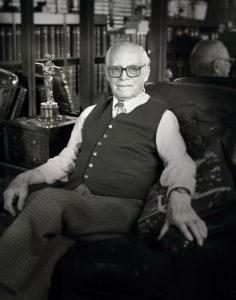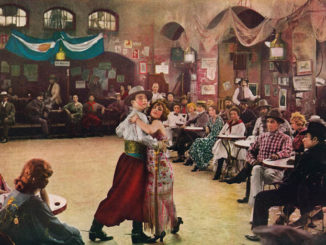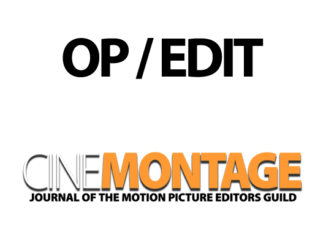
by Win Sharples, Jr.
You come into this course thinking of Casablanca as a Bogart-Bergman flick,” I would say during the first lecture of my History of Cinema course. “But you will leave here thinking of it as a film by Michael Curtiz.” And so they did, for we were all awakening in those days to the notion that there was something definable as “cinematic”—that the film communicated character, concept and story in ways unique to cinema—and that the director was the dominant creative force, ringmaster, traffic cop, conductor, coach, author-auteur and final repository of the critical buck. But he is surely not the whole awesome three-ring show. Indeed, Casablanca, that “film by Michael Curtiz,” is the product of diverse contributions from, among many, the Epsteins and Koch (screenplay), Edeson (camera), Steiner (score) and, to our point, a man named Owen Marks.

I know that no student left our classroom thinking of Casablanca as “a film by Owen Marks.” And I’d wager that few scholars could enumerate Marks’ credits (among them Angels With Dirty Faces, The Treasure of the Sierra Madre, White Heat, East of Eden and The Hanging Tree), or discern and articulate the stylistic traits throughout his work. Lee Garmes, Bernard Herrmann and Dudley Nichols may have escaped anonymity, but Hollywood history is still full of unsung craftsmen whose work deserves to be recognized. And of all those who have contributed their naves and gargoyles, vault bosses and flying buttresses to the cathedral of film, few labor as invisibly as the film editor. In fact, on the rare occasions when his craft is recognized, his individual contribution is still ignored. The long entries on editing in The International Encyclopedia of Film (2,800 words) and The Oxford Companion to Film (1,250 words) contain the name of not one editor. Clearly, some work needs to be done.
Once I heard Lee Garmes respond to a challenge of his modest assertion that the lighting and filming of the “Sternberg” films was his own, by saying, “Take a look at his work before and after we worked together, and take a look at mine.” This is precisely the point with editors; we must examine the work and perceive the patterns. To do this, we must know what films they made, and with whom; we need filmographies. Then, having charted the terrain, we can begin to explore it—to learn more about editors and their craft.
We must learn of the legendary William Hornbeck, the editor, acknowledged by his colleagues as “most admired,” whose introduction to film came at the table of his mother’s Los Angeles boarding house when a man named Sennett, newly arrived from the East, inquired as to where he might find the best weather and purchased the Hornbecks’ land; young Bill would soon rise from nine-year-old film rewinder to Keystone cutting room chief. We must begin to appreciate Hornbeck’s importance to the British film industry when, working for Alexander Korda in the Thirties, he established the cutting rooms that were to spawn the British school of editors. We must gauge Hornbeck’s contribution to George Stevens’ major films, through those enormous, luminous close-ups, drawn through each other with vast, agonizingly held dissolves (as in A Place in the Sun).
The International Encyclopedia of Film and The Oxford Companion to Film contain the name of not one editor. Clearly, some work needs to be done.
It is time for us to know the work of Conrad Nervig, winner of the first Academy Award for editing (Eskimo, 1934), and to know more about the giants of the cutting room: Ferris Webster, Dorothy Spencer, Daniel Mandell, George Amy, Bill Reynolds, Anne V. Coates, Warren Low, Ralph Kemplen. We should see how the accomplishments of these veterans have been extended by the brilliant “new generation” of editors: Antony Gibbs, Sam O’Steen, Gerald Greenberg, Fredric Steinkamp, Robert Wolfe. We must examine the contribution of Henri Colpi to the cinema of Alain Resnais (on Night and Fog, Hiroshima Mon Amour, and Last Year at Marienbad), and attempt to discern the shifting influences involving Truffaut and Godard and their two favorite editors, Agnes Guillemot and Cécile Decugis.
How did experience in the cutting room help shape the directorial careers of Dorothy Arzner, Robert Wise, Mark Robson, David Lean, Anthony Harvey, Seth Holt, Hal Ashby? What of the editors whose names are inseparable from those of their directors (Anne Bauchens with De Mille, Michael Luciano with Aldrich, Jacques Gaillard with Chabrol)? How can Richard Lester’s films, with their innovative editing and stylistic consistency, be the work of four different editors (Bill Lenny, John Jympson, Antony Gibbs and John Victor-Smith)? How much influence does Dede Allen have on an Arthur Penn film? Was High Noon in fact “remade” by Elmo Williams (who developed the strict correspondence of screen time with real time)? Can an editor’s work be stylistically consistent? (Most editors think not.) What, for that matter, is editing? (Most editors do have some idea of this.)
In response to our questionnaires, most editors denied that there is such a thing as a discernible editing style, and then went on to reveal that they could readily spot the work of certain colleagues through their “fingerprints” (read: style). Most of them believe that style is far more a matter of the director’s temperament (vide Richard Lester). And they define editing as a response to the material presented them, and the telling of a particular story at hand in the best possible way. They say that the finest editing accomplishes all this invisibly—invisible even to colleagues!
We must gauge William Hornbeck’s contribution to George Stevens’ major films, through those enormous, luminous close-ups, drawn through each other with vast, agonizingly held dissolves.
They deny that there was ever a “studio style” in editing (fast at Warners, measured at Metro); if there was one, they say, it was a product of camera work and art direction. But they then recognize the stylistic influence of such gifted and powerful supervisors as Margaret Booth (who from 1939 to 1968 screened, and advised on the structure of, every MGM movie), Barbara McLean (supervising editor at Fox) and Darryl Zanuck (frequently cited as the producer who best understood the importance of editing, and who rigorously and consistently controlled the editing on all his pictures).
The personal hallmark of an editor—as suggested by their responses to our questions—is modesty. Rarely does an editor claim to have “made” (or remade) a movie.
They give that credit to the man they worked most closely with: the director. And we’re not necessarily challenging that assumption here. But in Golden Age (or assembly-line) Hollywood, at least, many directors had no opportunity to supervise the editing. They were already working on another picture, and the job of assembling the 600 or so separate scenes into a coherent narrative was left to the editor. If this is something less than an art, it’s still something more than a craft. Whatever editing is, we’re celebrating it in these pages.
To help us celebrate the 70th anniversary of the Motion Picture Editors Guild, our colleagues at the prestigious film journal Film Comment in New York have allowed us to reprint copy from their special 24-page section celebrating film editors––“Prime Cut”––which appeared in the March-April 1977 issue. While the bulk of their salute was a semi-exhaustive list of filmographies of the top 75 editors (Film Comment’s selection) from the United States, Great Britain and France, we decided to forego that element, since it only covered up to 1977––and besides, those credits are readily available today on IMDb. We retained their 75 choices, however, as well as other parts of their section: editors’ answers to questions about editing techniques and their best work, and an interview with Robert Wise about cutting Citizen Kane.
So, beginning above and continuing in the articles “Top 75 Picture Editors“, “My Best Work“, “Film Editors Forum” and “As the Editor, You’re the Audience” , everything––save for some photos, captions and headlines––is the work of the Film Comment team from 1977. Special thanks to our writer Kevin Lewis and especially Film Comment’s Sayre Maxfield (who is still with the publication today) for making all of this happen. – The Editor





